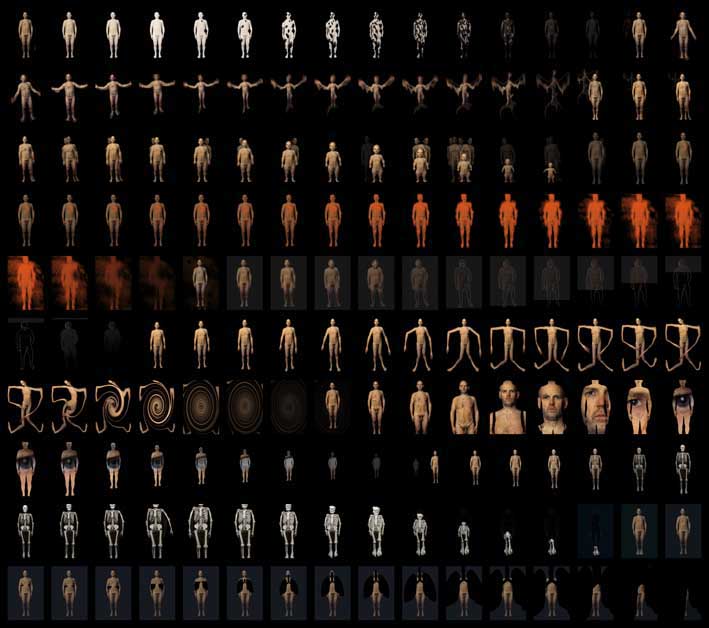
Things Happen. 2006. A time-based piece on the development of genetic diseases produced for Genes And Genius, Mendel Museum, Abbey Of St Thomas, Brno, Czech Republic. This is where the Abbot Gregor Mendel completed his famous studies on sweet peas, which revealed the basic laws of heredity. The work looks at how a view of 'self' is developed, how we can now see we are so closely linked to one another, through the revelations made by geneticist's, as they uncover how diseases are transmitted through the corruption of our genetic code. The work was planned as a piece that explored some of the various genetic diseases that affect mankind. There was a notion that the work might be envisaged as a time line of the points of discovery of these conditions by those like George Huntington, Charles Hunter, Howard Henry Tooth and others who uncovered the roots of these conditions in our genetic inheritance. Some of these ideas are held in the final piece and some are lost, The work developed through dynamic conversations with Bernadette Modell, Professor of Community Genetics, [Dept of Primary Care and Population Science, Royal Free Hospital and University College London, School of Medicine] and Dr Caterina Albiano of Artakt, Central St Martins School of Art, London. These often tragic conditions that lie beneath our surface are encoded in or miss-encoded in the language of our genes. Each section of the work takes a condition and applies it to a body until it has its final outcome most often in the destruction of the body. I used my body in the case of this work; I felt I wanted some strong connection with the effects of the condition. Some of the conditions are fatal and some are not; they may affect the blood and lymph system, the digestive system, or the muscle and bone system and include: fibrous dysplasia, achondroplasia and alkaptonuria. (© Andrew Carnie)
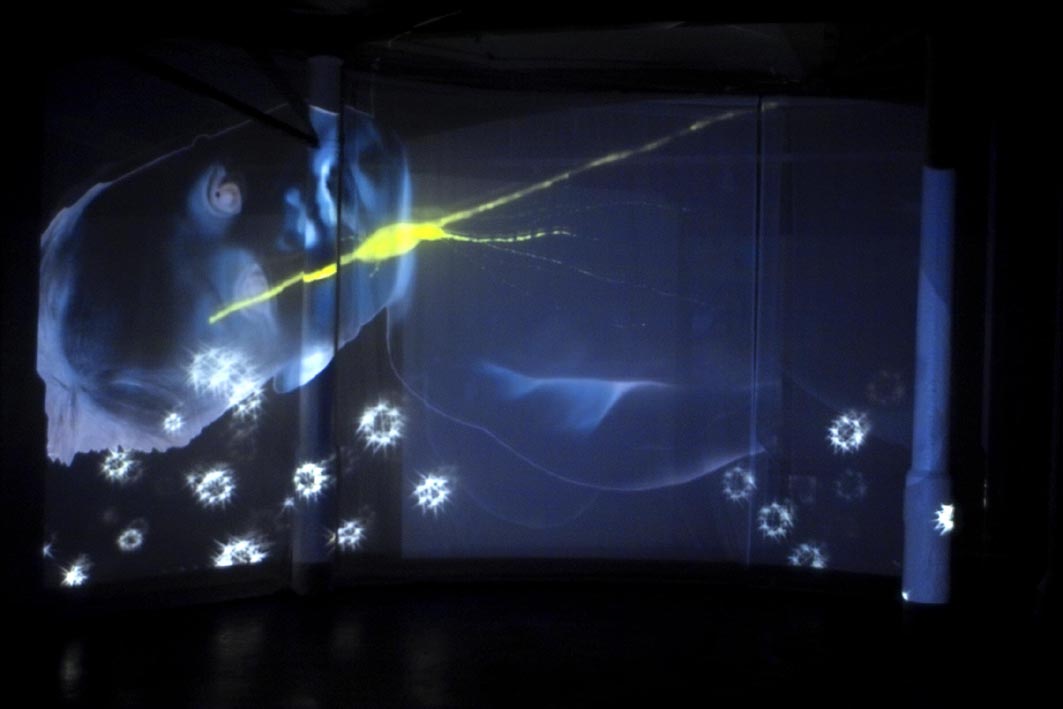
Complex Brain; Spreading Arbour. 2004. Andrew worked on this project with the neurologist Dr Richard Wingate, of the Developmental Neurology Department, Kings College, London. Together they created a time based video work based on the development and changes in the growing brain; looking specifically at the migration of neurones out of the brain and into the body. The work uses two video projectors circling around a double-layered 8-meter circular voile screen in opposing directions to project the animated drawings of the neurones streaming through the body. A Wellcome Trust Medicine In Society Award funded this work. The work is 25 minutes in duration. This work was first shown at British Association Festival Of Science, Exeter, in 2003. The exhibition included the works Magic Forest and Calcium Caving. (© Andrew Carnie)
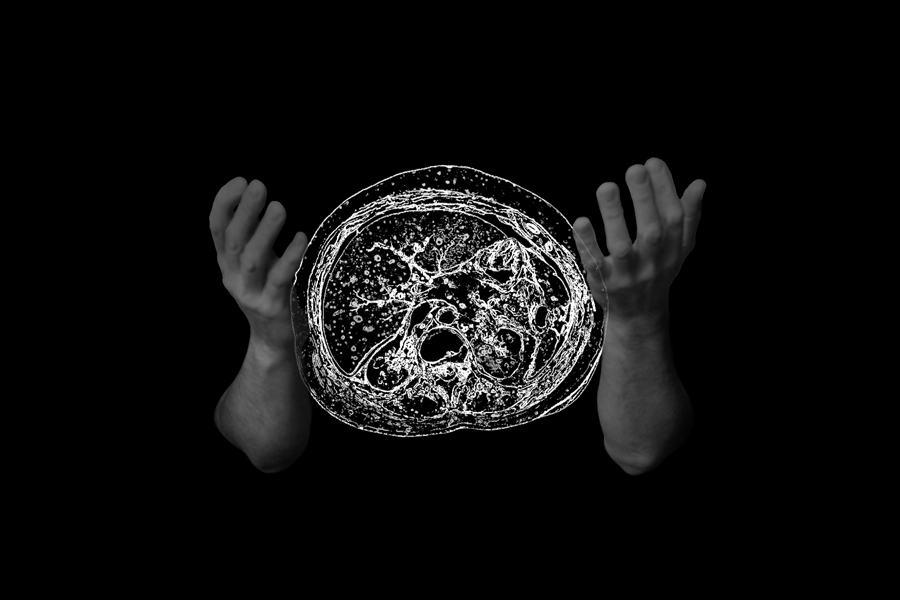
Slice. 2004. Is a slide dissolve work using two projectors that sit at opposite ends of a space projecting sequences of images onto three semi-translucent screens that lie between them. The projected slides rise from one-side and then dissolve into images rising from the other-side. The images start with one of the top of a head and image-by-image move through the whole body to the toes, in about 81 slides. The same happens in reverse working back to the head in another 81 slides. As the sequence develops changes happen, the images move from realistic representations to more abstract diffuse forms, the body seems to move picking it self up and colours change, from black and white to full ‘bloody’ colour. (© Andrew Carnie)
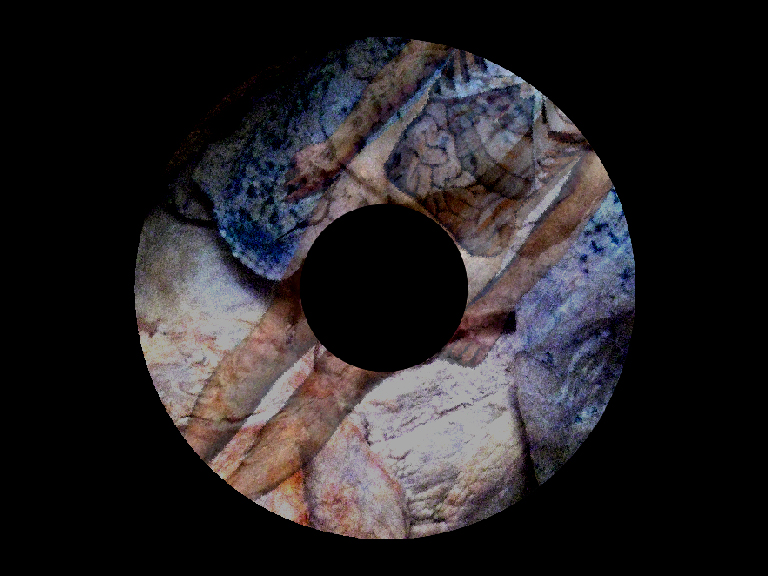
Eye: Through The Mirror Darkly 2004. Is a video projection piece. The images are projected onto a voile screen in the form of a truncated cone, the smaller part of the cone is fixed to the wall, the larger circumference floats perpendicular to the floor, away from the wall and into the gallery. The projected images consist of a series of stills, all based around medical-imaging techniques. The work is part of a project involved in looking at the ways concept of self have changed through images and ideas spawned by science. The work is 20 minutes in duration and was shown at the Picker Gallery Kingston in the show Slices and Snapshots, 2004. (© Andrew Carnie)
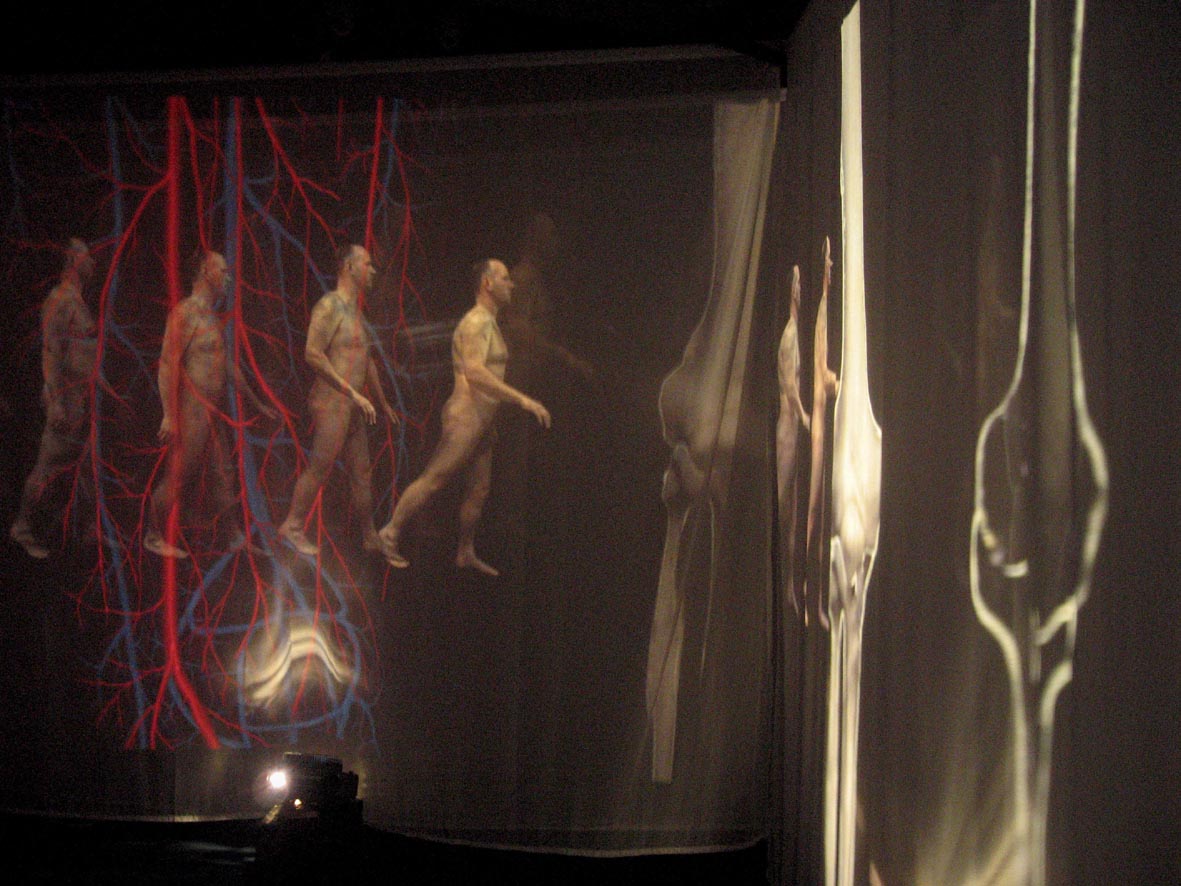
WAWWA. 2006. With Arts Council Funding and linked with neuro-architects and scientists the work We Are Where We Are was developed for the Space, Architecture and the Mind conference March 2006, part of Art and Mind, www.artandmind.org. The work, an examination of the architecture of the body, is projected by eight slide projectors onto a square of voile screens. The piece can be viewed from inside or outside the square. Through a sequence of slides, the various systems and component structures of the body come and go on a gigantic scale and walking figures come and go through the body forms created. Prints from the work were exhibited in the London Print Studio Gallery in 2006. (© Andrew Carnie)
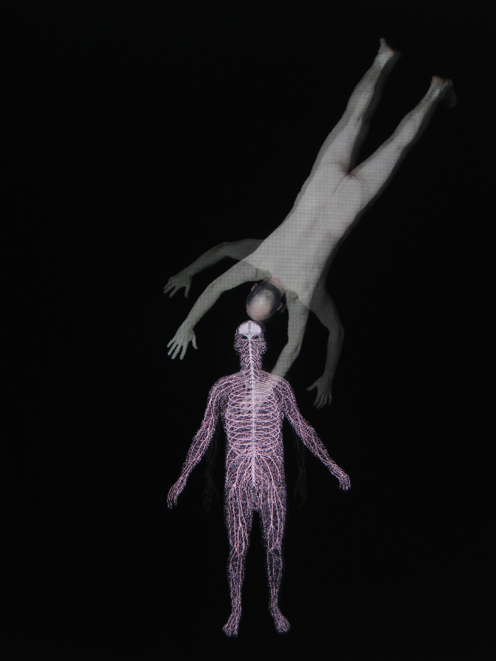
Host. 2007. A three screen video piece includes the projection of three short video works of various lengths played together in cycles onto different screens. The videos are Withdraw 10 minutes, Dance 20 minutes, and Spin 14 minutes long, projected onto a black voile screens suspended just off the wall surface by 4 ins. In each projection a hand-drawn neural network gyrates and dances in relation to a moving human form over-laying or under-laying it in one form or another. (© Andrew Carnie)
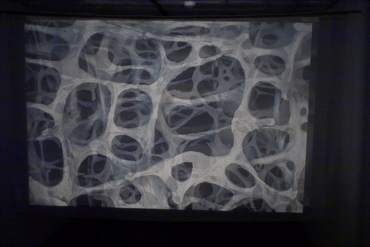
Calcium Caving. 2003. Images of the skull in mid-sagital cross section repeatedly advance increasing in scale. Starting as a dot on the screen the skull gets bigger and bigger and fills the screen until another cycle begins and then another. At times the cycle deviates from this norm and the image devolves into spongy bone formations or expands on the river like formations in the skull where cerebral arteries have impressed themselves on the bone, or a large numbers of cross sections sit upon one another like a cross section through a tree. Shown at the Winchester Gallery in the show 451 and at the British Association Festival Of Science, Exeter, in 2003. 162 images lasts about 22 minutes. (© Andrew Carnie)
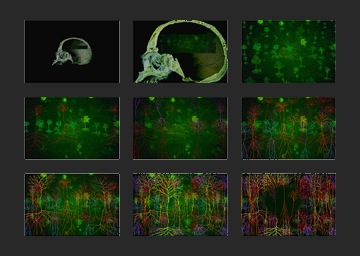
Magic Forest. 2002. Was made for the exhibition Head On in 2002, a show at the Science Museum on neurology and the brain. The work was produced in collaboration with Wellcome Foundation. The final work is a dream-like journey through a sea of developing neurones, expanding and expanding in number. The work was dependent on research about the Spanish anatomist Santiago Ramon Y Cahal and on the contemporary work of Dr Richard Wingate of the Medical Research Centre for Developmental Neurobiology, Kings College, London. Magic Forest was shown at the Science Museum in March 2002, at the Rotterdam Film Festival, Rotterdam, Holland, 2003 and at the Natuurmuseum, Rotterdam, a show called Mensbeeld, in 2004, in Simply Complex at the Design Museum in Zurich in 2005, in Neuroculture, at the Westport Art Centre, Connecticut, USA in 2006, and Brain Waves at Exit Art in New York 2007 and in Landscapes of the Mind at Williams College Museum of Art in 2009. Two articles have appeared in the journal Nature about Magic Forest. A static version of the time-based piece is now based at the Wellcome Trust Headquarters, London. (© Andrew Carnie)
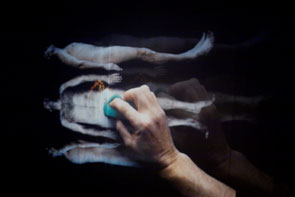
Disperse. 2002. A dissolve work made for the School of Hygiene and Tropical Medicine, London, in 2002. Ostensibly Disperse is a work that explores the hygiene aspects of the disposal of the body after death through various cultural forms of burial, from cremation to burial at sea. More though, it relates to thoughts about the departure of the human body at death. The work looks at processes of how the body might be physically dispersed; be rendered back to atomic particles. This work was shown later at the Headquarters of Amnesty International, London, at the Winchester Gallery, Winchester and at Kingston University during the Drawing conference of 2005. (© Andrew Carnie)
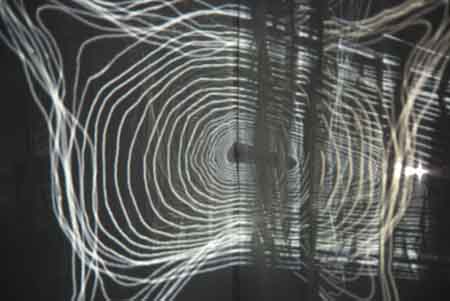
Crazy Diamond Cave. started 2004 completed 2010-11. a four-projector slide dissolve work lasting approximately 25 minutes. a projected line traces out a drawn image onto two intersecting perpendicular screens, 'cross like' if seen from above. each projector is set at the four points of the screens, about 2 meters out projecting at the end of the screen. the images are projected around this screen following a circle clockwise motion, one projector taking over slowly from the previous projector, the image from the fading projector lingers as the next image becomes brighter. the images take the viewer on a time-based journey through a series of linear spaces, quite wild in their appearance, a journey down a tunnel into new and unknown places. (© Andrew Carnie)
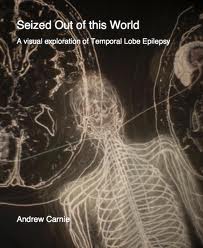
SEIZED: OUT OF THIS WORLD A visual exploration of Temporal Lobe Epilepsy and its creative effects Temporal Lobe Epilepsy, TLE, has affected many creative individuals and is thought to be the source of much artistic inspiration. Artists like Vincent Van Gogh and Fydor Dostoevsky are just two such significant creative people. The electrical storms associated with this condition are considered to cause a kind of cross-pollination of ideas between different functional areas of the brain, giving the artists extraordinarily insightful visions, which feed into their creative practice. Much of the work and research that exists is visual leading to a goldmine of information for an artist like myself interested in the visual and the underlying neurological condition. The sequences within the time-based work ‘Seized Out of this World’, deal with particular elements of Temporal Lobe Epilepsy as described in Geschwind Syndrome which is a personality syndrome consisting of symptoms such as circumstantiality, excessive verbal output, hypergraphia, writing or drawing a lot, altered sexuality, often hyposexuality, but it can be hypersexuality, an intensified mental life, deepened cognitive and emotional responses, hyper-religiosity and or hyper-morality. Sufferers also frequently experience déjà vu, where a new encounter is felt to have been experienced before, or jamis vu, where the sufferer does not recognize a familiar situation. TLE sufferers often have a number of these characteristics to one degree or another. Some sufferers also experience out of body sensations and historically sufferers were thought to have been affected by external powers. All these characteristics have fed the various sections of the time-based work ‘Seized’. Behaviours associated with this syndrome can be seen both in the inter-ictal, (between seizures}, and the ictal, (during seizures), states. The condition is widespread throughout the world and the severity of seizures people suffer from can vary a lot. Those who suffer from epilepsy are frequently stigmatised by the condition as it can interrupt their pattern of daily living; though modern drugs can often control the seizures. The syndrome is known after the two doctors who undertook a great deal of work in the field of TLE and who first characterized the syndrome, Norman Geschwind and his colleague Stephen Waxman. The syndrome describes a range of behaviours and personality features associated with the condition and makes it seem more like a specific psychiatric disorder, and as such has been criticised for this element because underlying it is a neurological condition; some form of scar tissue within the brain specifically within the temporal lobe region. Seized, is a time-based work using three pairs of projectors. Each pair of projectors projects images onto three semitransparent voile screens set between the projectors. In each pair images rise from one projector and then dissolve into images from the second projector. Each set of projectors works through its slide sequence independently from the other pairs showing primarily the same sequence of images with some variations. The same images will be seen at one time or another on all the screen sets but rarely at the same time. The work ‘Seized’ was made with support and direction from Paul Broks, neuropsychologist, Senior Lecturer in Clinical Psychology at Plymouth University and Honorary Consultant in Neuropsychology at Derriford Hospital, Plymouth and Dr Adam Zeman, Professor of Cognitive and Behavioural Neurology, University of Plymouth. Both shared their knowledge and understanding of Temporal Lobe Epilepsy and arranged for me to meet patients who kindly gave me time to talk to them about their condition and the effects it had upon them which all fed into the production of ‘Seized Out of this World’. (© Andrew Carnie)
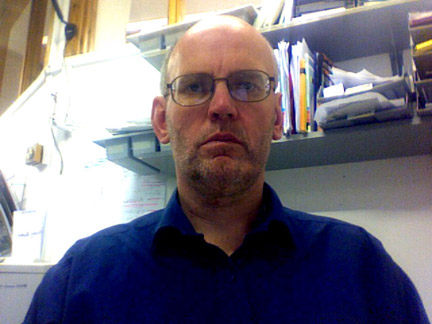
Andrew Carnie
BIO
Andrew Carnie was born in 1957 and lives and works in Winchester and London as an artist and lecturer. He studied chemistry and painting at Warren Wilson College, North Carolina, then zoology and psychology at Durham University, before gaining a BA in Fine Art from Goldsmiths College and an MA in Painting at the Royal College of Art.
His current practice concerns various scientific topics, primarily in the form of time-based installations. For ‘Head On', a show on neurology at the Science Museum (in collaboration with the Wellcome Trust) Carnie produced a number of pieces of work centered around memory, the brain, and neuroscience, while working with neuroscientists at the Medical Research Center for Developmental Neurology, Kings College, London. The final work ‘Magic Forest' was shown at the Science Museum in March 2002.
In July 2002, Carnie presented ‘Disperse', a new work produced for 'Hygiene - the art of public health' at London School of Hygiene and Tropical Medicine in London. The work explores ideas around 'removal' and thoughts about the departure of the human body at death, looking at processes by which the body might be physically ‘dispersed'; be rendered back to atomic particles. This work was shown again at the Headquarters of Amnesty International, London, and at New College, Southampton, in November 2002.
Carnie has also run other ventures alongside his practice, like the Carnie Chaple Gallery from 1986 to 1988, and the Tram Depot Gallery, from 1994 to 1996. He has worked as a consultant for Greater London Arts and taught regularly at the Winchester School of Art since 1991 . His work has been exhibited extensively, both nationally and internationally. His solo shows include; ‘Disperse' at the Amnesty International Headquarters in London in 2002, 'Embark' at the Millais Gallery in Southampton in 2002, ‘Fit to Travel' at the Tram Depot Gallery in London 1998, ‘Return Journey' at Columbus University Gallery in Georgia in 1997 and 'Organic' at the Tram Depot Gallery in London in 1995.
Group exhibitions have included; 'Hygiene - the art of public health' at the London School of Hygiene & Tropical Medicine, 'Head On' at the Science Museum in London and ' Silent Motion' at the Picker Gallery in London in 2002, 'Urban Shores' at the Dash Gallery in London and 'Art and Architecture' at the British Airways Headquarters in 2000, 'Summer' at the Sun & Doves Gallery in London in 1999, 'Plasticity' at The Pear Room in Hecklington in Lincolnshire in 1998, the 'John Moores 16 Exhibition in Liverpool in 1989 and the 'Whitechapel Open' at the Whitechaple Gallery in London in 1987, 1989 and 1994. His work is represented in collections in England, Germany, and the US. Gallery representation by GV Art London 49 Chiltern Street London W1U 6LY, United Kingdom 020 8408 9800.
























